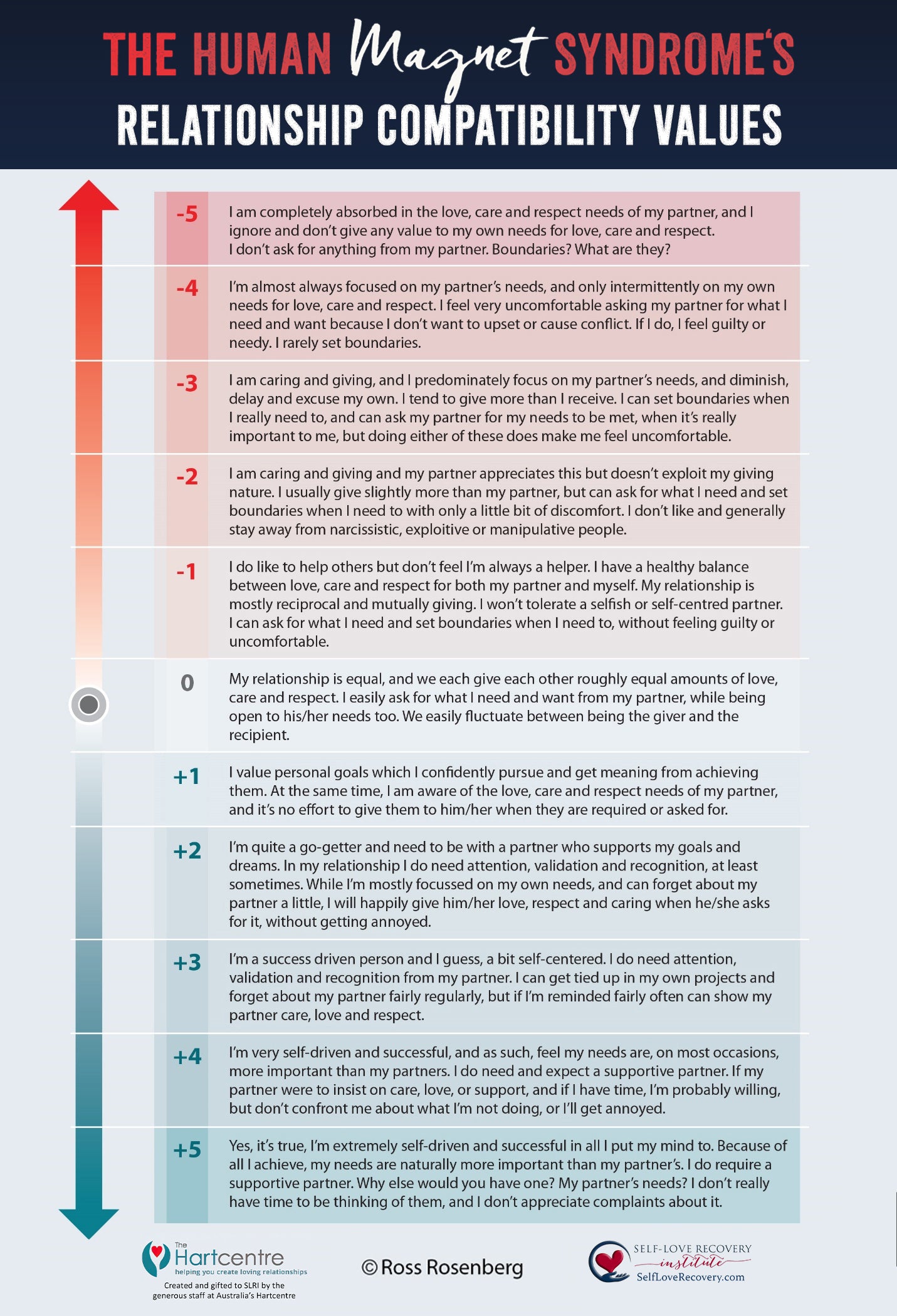The Relationship Compatibility Theory

The Relationship Compatibility Theory is a universal theory that measures the distribution of Love, Respect, Caring and Trust (LRCT) in all intimate relationships that are initiated through the unconscious matching of relationship templates using a Continuum.
The theory applies to all individuals, ranging from those who are psychologically unhealthy to those who have healthy mental health and illustrates how opposingly matched chronic caretakers, or codependents, match up to care-needers, the selfishly narcissistic individuals. It represents how opposite personality types interact in a relationship and how they do or do not express their emotional, psychological, and relational needs. It suggests all people are consciously and unconsciously attracted to romantic partners whose LRCT patterns correspond with their own.
The continuum represents how opposite personality types interact in a relationship and how they do or do not express their emotional, psychological, and relational needs. In more specific terms, it represents the distribution patterns of love, respect, and care in a relationship. This theory suggests all people are consciously and unconsciously attracted to romantic partners whose LRC patterns correspond with their own.
Relationship Orientation Values (RCVs)
A Relationship Orientation Value is the number assigned on the Continuum, ranging from a (-5) to (+5). The “positive” and “negative” term represents the flow of the Continuum’s numbers, and not the mental health of the individuals. Each side is numbered one through five, with the negative numbers on the left and the positive on the right. The Others Oriented individuals are represented with a range from a (-1) RCV to a (-5), whereas Self-Oriented individuals range from (+1) to (+5). When creating the Continuum Theory, I did not assign the negative numbered Others Relationship Oriented individual to be less desirable than the positive numbered Self Relationship Oriented individual. The division was made by happenstance, without any consideration of one being either “better” or “worse” than the other. In other words, the positive and negative terminology are quantitative designations, not qualitative.
Yet again, it is important to mention, The Relationship Compatibility Theory and its Continuum, like the Human Magnet Syndrome Theory, represent all people–from healthy to dysfunctional. People with healthy Relationship Orientations neither accept nor tolerate a relationship that lacks personal, emotional, or relational equity and fairness. This fact is important to consider as the Continuum was designed to represent all possibilities, but more importantly, the “movement” from healthier to more dysfunctional.
RCV Examples
The following list matches each of the 11 Relationship Compatibility Values (RCV) with a general personality description. These examples illustrate the wide variety of general personality possibilities, according to the Relationship Compatibility Theory.
(-5) Relationship Compatibility Value: A codependent who is completely absorbed with the LRCT needs of others, while completely ignoring and devaluing their own. They are often powerless and unable or unwilling to seek LRCT from their romantic partner and closest friends.
(-4) Relationship Compatibility Value: Someone with codependent tendencies who is almost always focused on the LRCT needs of others, while only intermittently seeking to have their own LRCT needs fulfilled. They are able, albeit unmotivated, fearful, and/or inexperienced in seeking LRCT from a romantic partner. They often choose not to ask others to fulfill their LRCT needs, as they do not want to upset others or cause conflict. If asking for some semblance of LRCT from their partner, they do so nervously and with distinct feelings of guilt or neediness.
(-3) Relationship Compatibility Value: One who identifies with their own caring and giving nature. They are predominantly focused on the LRCT needs of others, while often diminishing, delaying, or excusing away the fulfillment of their own needs. Their identity and reputation are fused with their helping and caretaking nature. They are typically in imbalanced relationships regarding their LRCT needs—giving much more than receiving. They are capable of setting boundaries in relationships, while also asking for what they need; however, they tend to feel guilty or needy when setting such boundaries or when asking for help from others.
(-2) Relationship Compatibility Value: One who is involved in relationships in which their caretaking identity is valued and appreciated, but not exploited. They enjoy relationships in which they provide ample LRCT, without wanting equal amounts reciprocated. They are comfortable with a partner who needs more LRCT than he or she is willing to give in return. They can set boundaries and ask for what they need, though they feel slightly uncomfortable doing so when the LRCT balance goes beyond their comfort level. They might experience mild feelings of guilt or neediness when asking a partner to meet their own LRCT needs. As much as possible, they avoid individuals who are narcissistic, exploitative, or manipulative.
(-1) Relationship Compatibility Value: Someone with a healthy balance between love, respect, care, and trust for themselves and others. They typically seek life experiences and relationships in which they can satisfy their own LRCT needs. They tend to participate in and appreciate relationships based on a reciprocal and mutual distribution of LRCT. Although they derive meaning and happiness from helping and caring for others, they will not tolerate a selfish or self-centered romantic partner. They often enjoy caring for others, but do not identify as a caretaker or helper. They do not feel guilty or needy when asking for LRCT from others.
(0) Relationship Compatibility Value: Someone who participates in relationships where there is an equal distribution of LRCT given and received. They easily ask for what they need from their partner, while being open to their LRCT needs. In a LRCT-balanced relationship, they easily fluctuate between being the recipient and the giver.
(+1) Relationship Compatibility Value: Someone with a healthy balance of love, respect, and care for themselves and others. They tend to participate in and appreciate relationships based on a reciprocal and mutual distribution of LRCT. They value personal and professional goals and ambitions, which they confidently pursue. Although they derive meaning and happiness from the pursuit of their own aspirations, they are also cognizant of the necessity to love, respect, and care for their romantic partner. They effortlessly provide LRCT to their romantic partner when necessary or requested. They may identify with the role of both caretaker and helper while wanting to fulfill their own desires.
(+2) Relationship Compatibility Value: One who prefers to be involved in a relationship in which their pursuit to fulfill their own hopes and dreams is encouraged and supported. In a romantic relationship, they actively seek attention, appreciation, and affirmation. Although they are go-getters and may be consumed with being in the spotlight, they are willing and able to fulfill their partner’s needs. They are neither exploitative nor selfish. Oriented towards their own LRCT needs, they periodically forget about the inequity of the LRCT distribution in the relationship. They respond favorably and non-reactively when their partner asks for greater amounts of LRCT. Although they can be comfortable in a caretaking role, they cannot maintain it.
(+3) Relationship Compatibility Value: Mildly selfish and self-centered, this is someone who is predominantly focused on the LRCT needs of themselves, while often diminishing, delaying, or excusing away the fulfillment of their partner’s needs. Their identity and reputation are fused with their need for attention, validation, and recognition. They identify with the persona of a go-getter and a success-driven individual. They are typically drawn to relationships where there is an imbalance in the distribution of LRCT needs, expecting or taking more than giving. If confronted about this inequality, they may get defensive, but will be able to make corrections. Although they may be perceived as self-consumed and self-centered, they are able to keep these qualities in check and are willing and able to love, respect, and care for their partner. They do, however, need frequent reminders.
(+4) Relationship Compatibility Value: Someone who is narcissistic and preoccupied with the LRCT needs of self, while rarely seeking to fulfill those of others. They come across as being entitled, self-absorbed, and self-centered as they are driven to seek LRCT from others but give very minimal amounts in return. They are comfortable with the LRCT disparity, believing their needs are more important than their partner’s. Although overtly narcissistic, they are still able to give nominal levels of LRCT to others. If confronted about the LRCT inequities, they will characteristically get angry and defensive and quickly try to justify their actions. They do not, however, experience a narcissistic injury or exhibit narcissistic rage when confronted.
(+5) Relationship Compatibility Value: A pathological narcissist who is unable and unmotivated to love, respect, and care for others. They are consumed with fulfilling their own LRCT needs and have no intention of reciprocating. They have great difficulty exhibiting empathy, unconditional positive regard, or love. When they do give LRCT to others, it is typically with strings attached. They are not able to comprehend or accept their pathological levels of narcissism. If confronted about the LRCT imbalances, they will often strike back with either direct or passive aggression.

Learn more by reading The Human Magnet Syndrome: The Codependent Narcissist Trap. Available here.
The above graphic was created and gifted to SLRI by the generous staff at Australia's Hart Centre.
